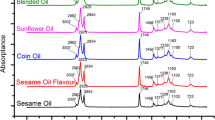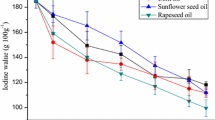Abstract
Sesame oil (SO), one of the most popular and expensive edible oils, is prone to adulteration. In this study, the fatty acid profiles of pure sesame seed oil and samples adulterated with two less expensive edible oils (canola and sunflower) were analyzed using Gas Chromatography. A dedicated e-nose system was developed and tested on 15 mixtures of sesame-canola and sesame-sunflower samples. Principal Component Analysis (PCA), Linear Discriminant Analysis (LDA), and Multi-Layered Perceptron (MLP) methods were utilized to identify adulteration through the evaluation of Volatile Organic Compound. Result of chromatography showed that most samples of sesame oil containing impurities at levels less than 30% were recognized incorrectly in the standard range of SO fatty acids. This is while the developed e-nose system was able to detect adulteration at much lower levels. According to the results, PCA and LDA methods can describe the data set variance with precision of 95.6% and 97%, respectively. The MLP model had better results compared to PCA and LDA, with high determination coefficient (R2 = 0.981) and low RMSE (0.0178). Results indicate that the e-nose system provided an effective non-destructive method to detect SO adulteration at levels as low as 5%, which GC was unable to detect.




Similar content being viewed by others
Data availability
The data that support the findings of this study are available on request from the corresponding author. The data are not publicly available due to privacy or restrictions and ongoing research work.
References
Astuti SD, Mukhammad Y, Duli SAJ, Putra AP, Setiawatie EM, Triyana K (2019) Gas sensor array system properties for detecting bacterial biofilms. J Med Signals Sens 9(3):158
Avian C, Leu JS, Prakosa SW, Faisal M (2022) An improved classification of pork adulteration in beef based on electronic nose using modified deep extreme learning with principal component analysis as feature learning. Food Anal Methods 15(11):3020–3031
Ayari F, Mirzaee-Ghaleh E, Rabbani H, Heidarbeigi K (2018) Using an E-nose machine for detection the adulteration of margarine in cow ghee. J Food Process Eng 41(6):e12806
Azadmard-Damirchi S, Torbati M (2015) Adulterations in some edible oils and fats and their detection methods. J Food Quality Hazards Control 2(2):38–44
Baldi P, Brunak S, Chauvin Y, Andersen CA, Nielsen H (2000) Assessing the accuracy of prediction algorithms for classification: an overview. J Bioinf 16(5):412–424
Celisse A (2014) Optimal cross-validation in density estimation with the $L^{2}$-loss. Annals Stat 42(5):1879–1910. https://doi.org/10.1214/14-AOS1240
Covington JA, Wedlake L, Andreyev J, Ouaret N, Thomas MG, Nwokolo CU, Arasaradnam RP (2012) The detection of patients at risk of gastrointestinal toxicity during pelvic radiotherapy by electronic nose and FAIMS: a pilot study. Sensors 12(10):13002–13018
Craven MA, Gardner JW, Bartlett PN (1996) Electronic noses Development and future prospects. J Anal Chem 15(9):486–493
Dou X, Zhang L, Yang R, Wang X, Yu L, Yue X, Li P (2022) Adulteration detection of essence in sesame oil based on headspace gas chromatography-ion mobility spectrometry. Food Chem 370:131373
Frank IE, Kowalski BR (1982) Chemometrics. Anal Chem 54(5):232–243
Hai Z, Wang J (2006a) Detection of adulteration in camellia seed oil and sesame oil using an electronic nose. Eur J Lipid Sci Technol 108(2):116–124
Hai Z, Wang J (2006b) Electronic nose and data analysis for detection of maize oil adulteration in sesame oil. Sens Actuators, B Chem 119(2):449–455
ISO 12966–2 (2011) Animal and vegetable fats and oils-Gas chromatography of fatty acid methyl esters- Part 2: Preparation of fatty acid methyl esters. International Organization on Standardization
ISO 12966–4 (2011) Animal and vegetable fats and oils-Gas chromatography of fatty acid methyl esters- Part 4: determination by capillary gas chromatography. International Organization on Standardization
Kalinichenko A, Arseniyeva L (2020) Electronic nose combined with chemometric approaches to assess authenticity and adulteration of sausages by soy protein. Sens Actuators, B Chem 303:127250
Kebede A, Bussa N, Kiros T (2017) Oil and meal quality of Ethiopian sesame varieties and their implications for quality improvement. Ethiop J Agric Sci 27(2):73–83
Kiani S, Minaei S, Ghasemi-Varnamkhasti M (2016) A portable electronic nose as an expert system for aroma-based classification of saffron. Chemom Intell Lab Syst 156:148–156
Lerma-García MJ, Ramis-Ramos G, Herrero-Martínez JM, Simó-Alfonso EF (2010) Authentication of extra virgin olive oils by Fourier-transform infrared spectroscopy. Food Chem 118(1):78–83
Malekahmadi R, Yasini Ardakani SA, Sadeghian A, Eslami H (2021) Rapid Detection of Adulteration in Mixing Sesame, Sunflower, and Canola Vegetable Oils by Mathematical Model. Food Anal Methods 14(7):1456–1463
Mildner-Szkudlarz S, Jeleń HH (2010) Detection of olive oil adulteration with rapeseed and sunflower oils using mos electronic nose and SMPE-MS. J Food Quality 33(1):21–41
Nam YS, Noh KC, Roh EJ, Keum G, Lee Y, Lee KB (2014) Determination of edible vegetable oil adulterants in sesame oil using 1H nuclear magnetic resonance spectroscopy. Anal Lett 47(7):1190–1200
Roy M, Yadav BK (2021) Electronic nose for detection of food adulteration: a review. J Food Sci Technol 59:1–13
Seo HY, Ha J, Shin DB, Shim SL, No KM, Kim KS, Han SB (2010) Detection of corn oil in adulterated sesame oil by chromatography and carbon isotope analysis. J Am Oil Chem Soc 87(6):621–626
Sun X, Zhang L, Li P, Xu B, Ma F, Zhang Q, Zhang W (2015) Fatty acid profiles based adulteration detection for flaxseed oil by gas chromatography mass spectrometry. LWT-Food Sci Technol 63(1):430–436
Tudor AM, Melia CD, Binns JS, Hendra PJ, Church S, Davies MC (1990) The application of Fourier-transform Raman spectroscopy to the analysis of pharmaceuticals and biomaterials. J Pharm Biomed Anal 8(8–12):717–720
Vaclavik L, Cajka T, Hrbek V, Hajslova J (2009) Ambient mass spectrometry employing direct analysis in real time (DART) ion source for olive oil quality and authenticity assessment. Anal Chim Acta 645(1–2):56–63
Wei X, Shao X, Wei Y, Cheong L, Pan L, Tu K (2018) Rapid detection of adulterated peony seed oil by electronic nose. J Food Sci Technol 55(6):2152–2159
Xu L, Yu X, Liu L, Zhang R (2016) A novel method for qualitative analysis of edible oil oxidation using an electronic nose. Food Chem 202:229–235
Zarezadeh MR, Aboonajmi M, Varnamkhasti MG, Azarikia F (2021) Olive oil classification and fraud detection using E-nose and ultrasonic system. Food Anal Methods 14(10):2199–2210
Zhang L, Shuai Q, Li P, Zhang Q, Ma F, Zhang W, Ding X (2016) Ion mobility spectrometry fingerprints: A rapid detection technology for adulteration of sesame oil. Food Chem 192:60–66
Funding
The authors declare that they have not received funding from any public or private sources.
Author information
Authors and Affiliations
Corresponding author
Ethics declarations
Conflict of interest
The authors declare that no competing interests exist.
Consent to participate
We authors voluntarily agree to participate in this research study and understand that we will not benefit directly from participating. We have had the purpose and nature of the study explained to us in writing, and we have had the opportunity to ask questions about the survey. We understand that the results of the research may be quoted in the list of all forums in which you plan to use the data from the interview: dissertation, conference presentation, published papers, etc.
Consent for publication
The authors affirm that neither the article nor portions of it have been previously published elsewhere nor is under consideration for publication in another journal. All authors consent to the publication of the manuscript should it be accepted by the journal.
Additional information
Publisher's Note
Springer Nature remains neutral with regard to jurisdictional claims in published maps and institutional affiliations.
Rights and permissions
Springer Nature or its licensor (e.g. a society or other partner) holds exclusive rights to this article under a publishing agreement with the author(s) or other rightsholder(s); author self-archiving of the accepted manuscript version of this article is solely governed by the terms of such publishing agreement and applicable law.
About this article
Cite this article
Hosseini, H., Minaei, S. & Beheshti, B. A dedicated electronic nose combined with chemometric methods for detection of adulteration in sesame oil. J Food Sci Technol 60, 2681–2694 (2023). https://doi.org/10.1007/s13197-023-05792-2
Revised:
Accepted:
Published:
Issue Date:
DOI: https://doi.org/10.1007/s13197-023-05792-2




